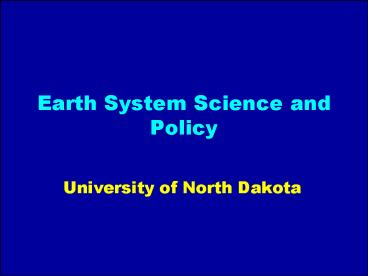Earth System Science and Policy PowerPoint PPT Presentation
1 / 34
Title: Earth System Science and Policy
1
Earth System Science and Policy
- University of North Dakota
2
First and Finest
- Unique Opportunity
- No others can ever be the first students in a
new program. - Corresponding Challenge
- You must assume responsibility for your own
education.
3
20th Centurys Main Lessons
- Cosmic Significance
- Spaceship Earth
- All Life Related
- Single Human Family
- Dawn of the Anthropocene
4
Cosmic Significance
Homo sapiens ancestry 0.001 of travel time of
these signals.
5
Spaceship Earth
Single, Interconnected System
Common Home for All Humanity
Benevolent Habitat for Diverse Life
Stunningly Beautiful
Fragile
6
One Earth
Space-Time Aerosol Distribution
7
Earthlife
8
The Family of Life
- All organisms made from
- Same matter
- Same set of amino acids (20)
- Same genetic material (DNA)
9
Human Family
10
Humans
- No races
- Human genome 99.9 same in all people
- We are a single family.
- Humans related to all other life
- share same ancestry.
- 95-98 same genes in humans
- apes
- 85 same genes in humans mice
11
(No Transcript)
12
Ecosystem or Human-made Services?
? Nutrient Recycling ? Water Purification ?
Climate Moderation ? Pollination ? Soil
Stabilization ? Genetic Archive ? Aesthetics
13
Future of Life
E.O. Wilson, The Future of Life (2002)
14
Human Domination--Land
- 39-50 of lands surface transformed.
- gt55 of biological productivity used by humans.
- Earths 3 most abundant plants rice, wheat,
corn - gt20 of plants on continents, gt50 on islands,
are non-indigenous - Vitousek et al., Science 277, pp. 494-499
(1997).
15
Human Domination--Water
- Humanity uses gt50 of surface freshwater
- In U.S., only 2 of rivers run unimpeded.
- Many rivers no longer reach the sea.
16
Human Domination--Atmosphere
17
Deeper Global Past
18
Global Future
- If nothing slows greenhouse gas emissions. . .
- CO2 concentrations will exceed 700 ppm by 2100
- Global average temperatures will rise 2.5 10.4 F
19
(No Transcript)
20
Global Experiment
- More people are using more resources with more
intensity than at any time in human history. - The pace of planetary re-engineering is
unsustainable.
21
Challenge Sustainability
- Sustainability
- Meeting peoples needs and values
- Preserving Earths vital life-support systems
22
ESSPs Approach
- Focus on how humans interface with nature
- Two-way exchange of information
- Earth System Science knowledge informing
decisions - Societal needs directing Earth System Science
- Solve problems, Seize opportunities, dont just
describe them.
23
Nature-Human Interface
24
Philosophy of Action
25
Triggering Change Locally
- Never doubt that a small group of thoughtful,
committed citizens can change the world. Indeed,
it is the only thing that ever did. - Margaret Mead
- Major Shifts in Societal Values originate at
local level. - Abolition of slavery
- Womens right to vote
- Civil Rights for African Americans
- Resurgence of Native Pride
- Adoption of Sustainable Practices?
26
Do What, When, How?
- Engage target community everyone both a teacher
and learner - Begin take steps possible now
- Adapt build on successes
- Be holistic integrate social, economic,
environmental, legal, political solutions - Communicate translate science into actions
27
Do What, When, How?
- Who knows everything about
- Every discipline?
- Every method?
- Every technology?
- No one!
28
Do What, When, How?
- When will knowledge of Earths systems be
perfect? - Never!
- But more known now than being acted upon.
29
ESSPs Components
- Environmental Information Bridge
- Solutions-Driven Research
- Data Acquisition/Dissemination
- Earth System Science Policy Degree
What is the status of Planet Earth?
What can be done to improve it?
What data underlie the application?
How will stewardship continue?
30
Organizing Complexity
- Major Cycles within Earths System
- Anthropogenic
- Biospheric Productivity
- Energy
- Material
- Hydrological
- Biogeochemical
- 3 cycles per semester in 5-week blocks
31
Principles of ESSP
- Consider Earth a unified system
- Think globally, act locally
- End goal of learning is an Action on path to
sustainability - Consider Humans part of the Earth System
32
Summary ESSP Education
- Learn by Doing
- Real-world, real-time problems and opportunities
- Full stakeholder involvement
- Work in Interdisciplinary Teams
- Student-centered
33
Ethical Component
- Sustainability dependent upon Justice and Equity
in 3 regimes - Intragenerational
- Intergenerational
- Inter-Species
34
(No Transcript)

